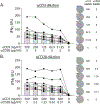Development and optimization of a diluted whole blood ELISpot assay to test immune function
- PMID: 39147231
- PMCID: PMC11398710
- DOI: 10.1016/j.jim.2024.113743
Development and optimization of a diluted whole blood ELISpot assay to test immune function
Abstract
Sepsis remains a leading cause of death worldwide with no proven immunomodulatory therapies. Stratifying Patient Immune Endotypes in Sepsis ('SPIES') is a prospective, multicenter observational study testing the utility of ELISpot as a functional bioassay specifically measuring cytokine-producing cells after stimulation to identify the immunosuppressed endotype, predict clinical outcomes in septic patients, and test potential immune stimulants for clinical development. Most ELISpot protocols call for the isolation of PBMC prior to their inclusion in the assay. In contrast, we developed a diluted whole blood (DWB) ELISpot protocol that has been validated across multiple laboratories. Heparinized whole blood was collected from healthy donors and septic patients and tested under different stimulation conditions to evaluate the impact of blood dilution, stimulant concentration, blood storage, and length of stimulation on ex vivo IFNγ and TNFα production as measured by ELISpot. We demonstrate a dynamic range of whole blood dilutions that give a robust ex vivo cytokine response to stimuli. Additionally, a wide range of stimulant concentrations can be utilized to induce cytokine production. Further modifications demonstrate anticoagulated whole blood can be stored up to 24 h at room temperature without losing significant functionality. Finally, we show ex vivo stimulation can be as brief as 4 h allowing for a substantial decrease in processing time. The data demonstrate the feasibility of using ELISpot to measure the functional capacity of cells within DWB under a variety of stimulation conditions to inform clinicians on the extent of immune dysregulation in septic patients.
Keywords: Adaptive immunity; Cytokine; Immune function; Innate immunity; Sepsis.
Published by Elsevier B.V.
Conflict of interest statement
Declaration of competing interest M.B.M., K.E.R., and I.R.T. are members of Immune Functional Diagnostics, LLC (IFDx LLC) and receive no direct financial compensation. IFDx LLC is developing predictive metrics in critical illness and this technology is evaluated in this research. S.C·B, L.L.M., R.S.H., and the University of Florida may receive royalty income based on a technology developed by S.C.B. and others and licensed by Washington University in St. Louis to IFDx LLC. That technology is evaluated in this research. C.C.C. and the University of Cincinnati may receive royalty income based on a technology developed by C.C.C. and others and licensed by Washington University in St. Louis to IFDx LLC. That technology is evaluated in this research.
Figures






References
-
- Vincent JL, Marshall JC, Namendys-Silva SA, et al. Assessment of the worldwide burden of critical illness: the intensive care over nations (ICON) audit. Lancet Respir Med. 2014;2(5):380–386. - PubMed
Publication types
MeSH terms
Substances
Grants and funding
LinkOut - more resources
Full Text Sources
Medical
Miscellaneous

